乳腺癌,美国在研的760项基金项目简述(2024)
时间:2024-09-09 23:00:27 热度:37.1℃ 作者:网络
乳腺癌(Breast Cancer)是全球最常见的癌症之一,尤其是在女性中。根据最新的统计数据,2020年全球新发乳腺癌病例超过230万,而预计到2040年,这一数字将增长至超过300多万例(增加 40%),死亡人数也将从2020年的约685,000例增加至超过100万例(增加 50%)【1】。
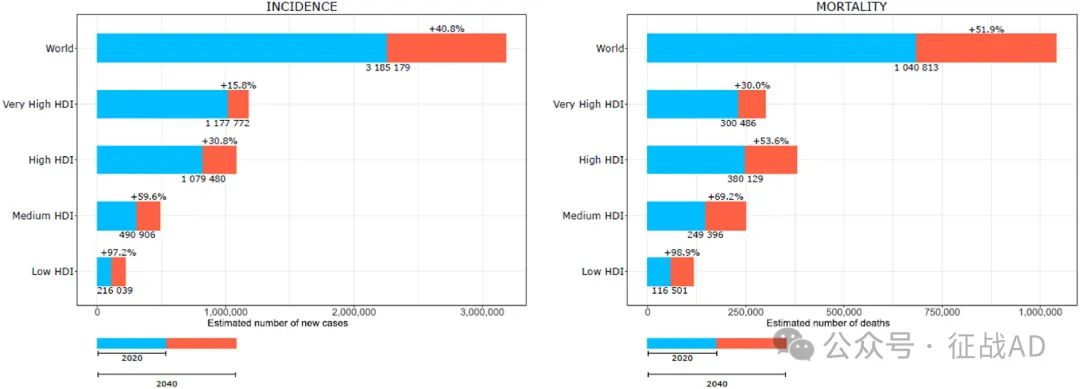
图. 2020-2040 年按人类发展指数(HDI)水平划分的估计乳腺癌病例和死亡人数【1】
尽管近年来在乳腺癌的诊断和治疗方面取得了显著进展,但仍存在一些重要而未解决的临床问题:
-
抗药性:尽管有多种有效的激素治疗和靶向治疗,如抗HER2疗法,部分患者会发展出对这些治疗的抗药性。研究和开发新的治疗策略以克服抗药性是当前的一个重要课题。
-
早期检测的困难:虽然乳腺癌的存活率在早期诊断时较高,但早期乳腺癌往往症状不明显,难以检测。改进早期筛查技术仍然是一个挑战。
-
副作用和生活质量:当前乳腺癌的治疗方法(如化疗、放疗和手术)常伴有长期或严重的副作用,这影响了患者的生活质量。开发更具针对性、副作用更小的治疗方法是未来的一个重点。
-
个体化治疗:虽然个体化医疗已经在乳腺癌治疗中取得了进展,但如何根据患者的遗传背景、肿瘤特性和个人偏好来优化治疗仍然是一个复杂的问题。
-
复发和转移的管理:乳腺癌复发和转移是主要的死亡原因。如何有效预测和管理复发和转移是当前研究的热点。
乳腺癌的治疗已经取得了显著进展,但为了进一步提高生存率和生活质量,上述临床问题的解决尤为关键。继续研究和开发新技术和疗法对于改善乳腺癌患者的治疗效果和预后至关重要。
我们仅对美国国立卫生研究院(NIH)资助的在研乳腺癌相关项目进行梳理,希望给同仁们的选题思路提供一点启发。
2024年,以“Breast Cancer”为检索词、在题目中进行检索,美国NIH针对乳腺癌的在研有760项。
一,谁获得了这些研究?
1,在研乳腺癌基金最多的PI
目前在研乳腺癌基金最多的PI主要包括:
-
DANA-FARBER CANCER INST 的 POLYAK, KORNELIA
-
BASIC SCIENCES 的 SHARAN, SHYAM
-
KAISER FOUNDATION RESEARCH INSTITUTE 的 KUSHI, LAWRENCE H
- VANDERBILT UNIVERSITY MEDICAL CENTER 的 PIETENPOL, JENNIFER A
- BASIC SCIENCES 的 HUANG, JING
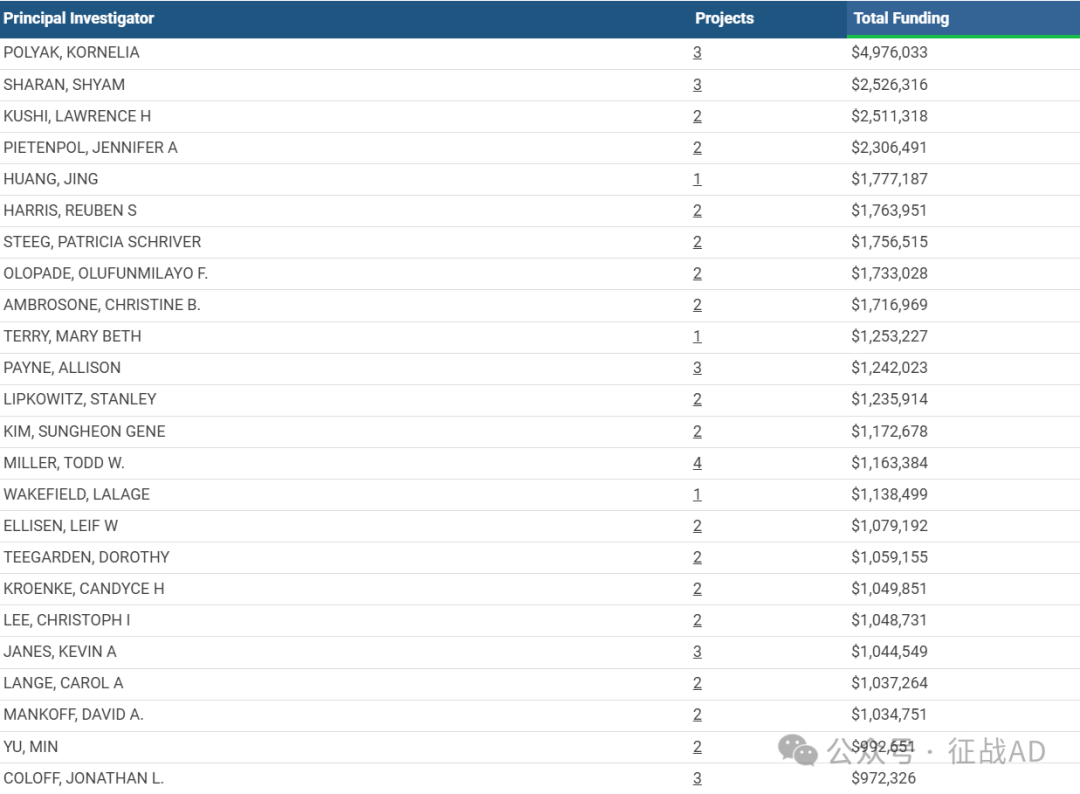
2,乳腺癌课题最多的研究机构
目前在研乳腺癌课题最多的机构主要包括:
-
德克萨斯大学 MD 安德森癌症中心
-
贝勒医学院
-
北卡罗来纳大学教堂山分校
-
罗斯威尔公园综合癌症中心
-
匹兹堡大学匹兹堡分校等

二,乳腺癌研究热点是什么?
乳腺癌研究领域总览(根据关键词)

A,关于三阴性乳腺癌(Triplenegative Breastcancer)的研究项目最多
有 179 项在研基金涉及到了三阴性乳腺癌,关注最多的方面包括小鼠模型(Mouse Models)、临床试验(Clinical Trials)、DNA、RNA、T细胞(T Cell)、AA TNBC等方面研究。
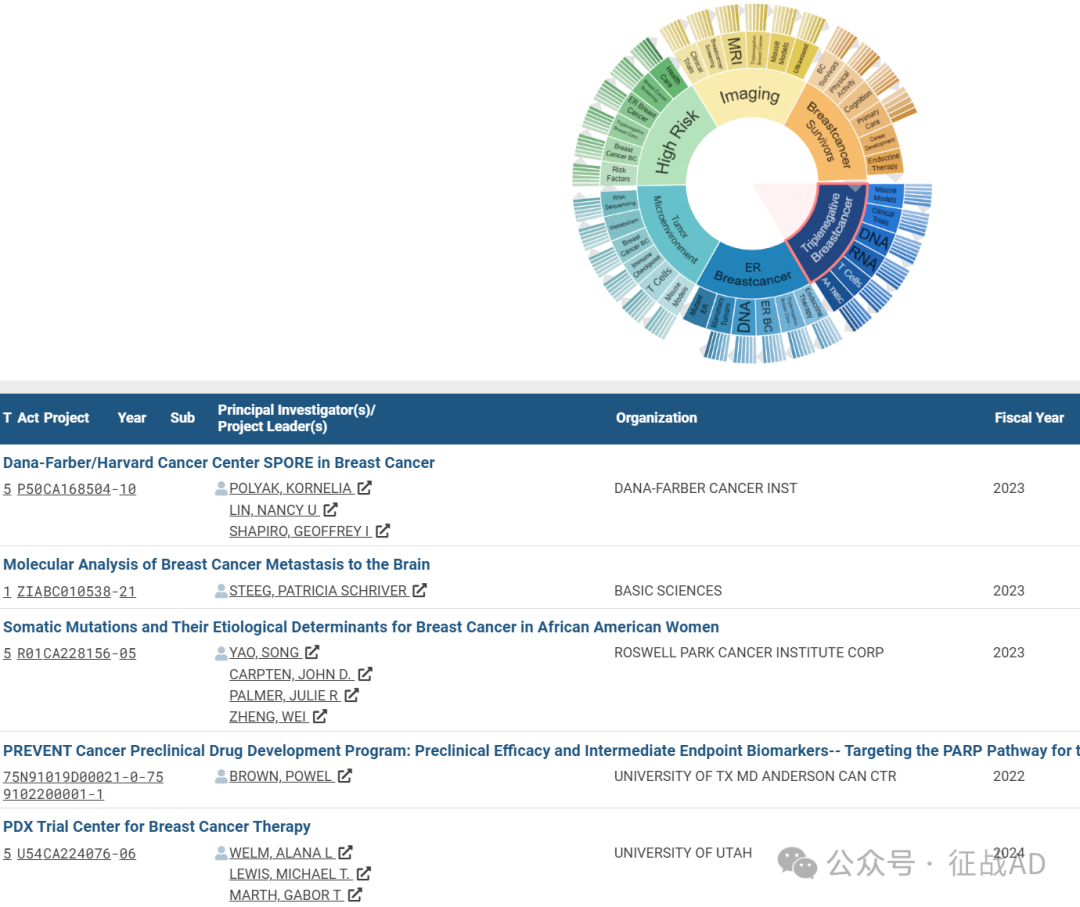
B,高风险(High Risk)的研究
有 109 项研究涉及到高风险,研究领域主要涉及风险因素(High Risk)、乳腺癌(Breast Cancer, BC)、三阴性乳腺癌(Triplenegative Breastcancer, TNBC)、雌激素受体乳腺癌(ER Breast Cancer)、乳腺癌筛查(Breast Cancer Screening)、健康保健(Health Care)等方面研究。
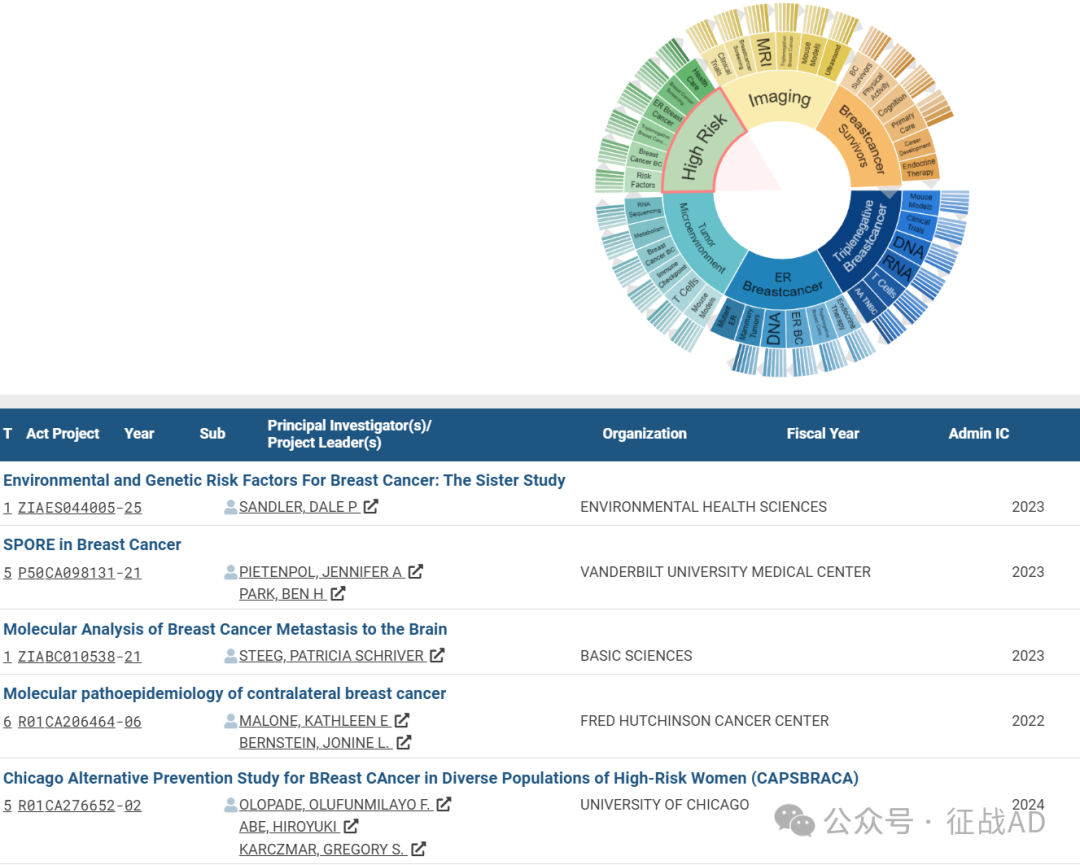
C,肿瘤微环境(Tumor Microenvironment)
有 108 项研究涉及到肿瘤微环境,涉及的关键词包括如小鼠模型(Mouse Models)、T细胞(T Cells)、免疫检查点(Immune Checkpoint)、代谢(Metabolism)、RNA测序(RNA Sequencing)等。
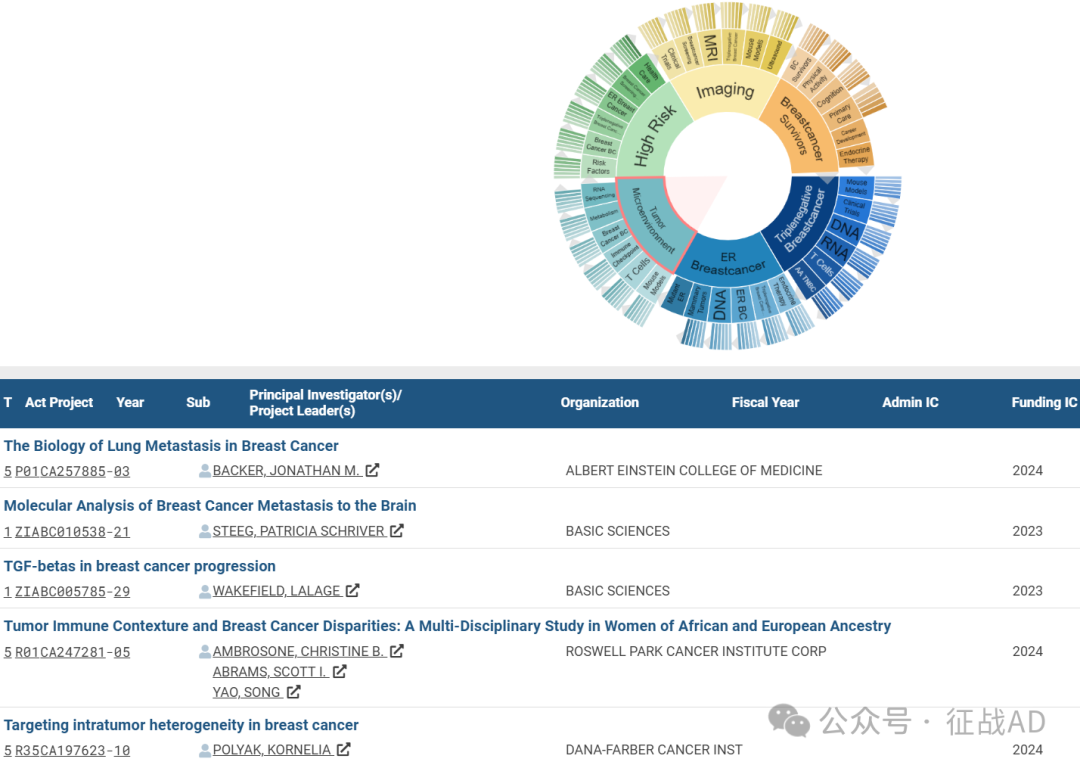
其他乳腺癌研究大的方向也包括影像(Imaging)、ER乳腺癌、乳腺癌幸存者(Breastcancer Survivors)等。
三,借鉴与突破
我们也分享在乳腺癌领域的几项课题摘要,希望对同仁们有所启发。
A,SPORE in Breast Cancer
Our overall goal remains the same: To conduct collaborative, multidisciplinary and mechanism-based translational research that will have the highest possible impact for women and men with or at risk for breast cancer.
After significant planning and internal and external advisory board evaluation, we propose four bi-directional translational projects addressing basic, translational and clinical research questions of importance in human breast cancer; Projects 1 and 2 are continuation projects, Projects 3 and 4 are new projects that have evolved from two CEP awards in the current funding cycle:
-
Project 1: Mechanisms of Resistance to Endocrine Therapy in ER+ Breast Cancer;
-
Project 2: Strategies to Improve Outcomes for TNBC Patients Integrating Subtype-specific Genomic and Immune-based Discoveries;
-
Project 3: Targeting the DNA Damage Response in Breast Cancer;
-
Project 4: Targeting Antigen Presentation to Improve Immunotherapy Responses in Breast Cancer.
The application also includes DRP and CEP, and four highly integrated shared core resources: Administration and Engagement, Biostatistics and Bioinformatics, Pathology and Tissue Informatics, and Immunophenotyping. The cores bring innovative technology and resources, including additional personnel with project-specific expertise, to the overall VICC Breast SPORE Program and do not duplicate pre- existing shared resources available at VICC or Vanderbilt University Medical Center (VUMC).
B, Mechanisms of Variant ER-alpha Function in Breast Cancer
Estrogen receptor-alpha (ER), a member of the nuclear receptor family of transcription factors, drives proliferation of breast cancer cells and is expressed in the majority of breast cancers. Tumors that express ER account for the greatest number of breast cancer associated mortalities. While targeting the ligand- dependent functions of receptor is a successful approach in the clinical management of breast cancer, ER can be activated by other means. This alternative activity of ER can promote ligand-independent properties and our lack of understanding of this activity creates a barrier to the clinical challenge of therapy resistance. We have found that phosphorylation of ER can modulate the regulation of multiple aspects of ER biology in tumor cells, including its fate and transcriptional function, in some cases leading to ligand-independence and resistance to therapy. We recently described a genome-wide DNA binding (i.e. cistrome) analyses of phosphorylated ER, specifically phosphorylation at Ser 118, and found that it has unique properties, including a novel association with Grainyhead-like protein 2 (GRHL2), a developmental transcription factor that has since been recognized to play a role in breast cancer.
Based on these novel findings and additional preliminary data, we hypothesize that pS118 and GRHL2 identify selective activities of ER that are necessary for growth of therapy-resistant tumors.
Toward addressing this hypothesis, we developed three lines of research.
Aim 1 exploits our cistromic analysis of pS118ER and a unique cohort of patient tumor samples to define, for the first time, the pS118ER activity in ER+ therapy-resistant tumors. Aim 2 will test the requirement for pS118ER and GRHL2 in growth and malignant phenotypes in cells bearing ER mutations, a genetic form of therapy resistance. This aim will use newly derived CRISPR edited cell models. Aim 3 will use novel DNA technologies to interrogate mechanisms of pS118ER and GRHL2 interactions on DNA and to develop DNA-targeting selective inhibitors.
Collectively, these three aims will employ patient samples, in vitro and in vivo approaches and unique technologies to interrogate how a post- translationally modified variant of ER contributes to the aberrant ER activity in recurrent tumors.
原文链接:
【1】https://doi.org/10.1016/j.breast.2022.08.010

